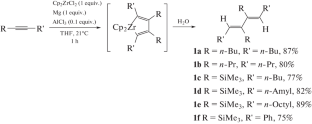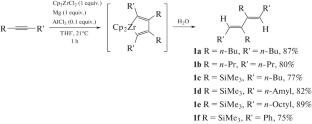在 Mg-Cp2ZrCl2 试剂体系作用下乙炔衍生物均偶联反应中 AlCl3 的活化效应
IF 1
4区 化学
Q4 CHEMISTRY, MULTIDISCIPLINARY
引用次数: 0
摘要
摘要 在烷基、苯基和硅基取代的乙炔与 Mg-Cp2ZrCl2 试剂体系的均偶联反应中,首次发现了 10 mol % 的 AlCl3 的活化效应。在路易斯酸 BF3⋅Et2O、Me3SiCl、InCl3 和 SnCl4 存在 10 摩尔%的情况下,与 5-癸炔的反应即使在 5 小时后也不会发生,而在 AlCl3 存在的情况下,在室温下 10 分钟内就能选择性地形成高产率的同偶联产物,这一事实表明了这种活化的独特性。本文章由计算机程序翻译,如有差异,请以英文原文为准。


Activating Effect of AlCl3 in Homocoupling Reaction of Acetylene Derivatives under the Action of Mg–Cp2ZrCl2 Reagent Systems
The activating effect of AlCl3 in the amount of 10 mol % in the homocoupling of alkyl-, phenyl-, and silyl-substituted acetylenes with the Mg–Cp2ZrCl2 reagent system was found for the first time. The unique nature of this activation is indicated by the fact that in the presence of 10 mol % of Lewis acids BF3⋅Et2O, Me3SiCl, InCl3, and SnCl4, the reaction with 5-decyne does not occur even after 5 h, while in the presence of AlCl3, homocoupling products are selectively formed in high yields within 10 min at room temperature.
求助全文
通过发布文献求助,成功后即可免费获取论文全文。
去求助
来源期刊

Doklady Chemistry
化学-化学综合
CiteScore
1.20
自引率
12.50%
发文量
7
审稿时长
6-12 weeks
期刊介绍:
Doklady Chemistry is a journal that publishes new research in chemistry and chemical engineering of great significance. Initially the journal was a forum of the Russian Academy of Science and published only best contributions from Russia in the form of short articles. Now the journal welcomes submissions from any country in the English or Russian language. Every manuscript must be recommended by Russian or foreign members of the Russian Academy of Sciences.
 求助内容:
求助内容: 应助结果提醒方式:
应助结果提醒方式:


